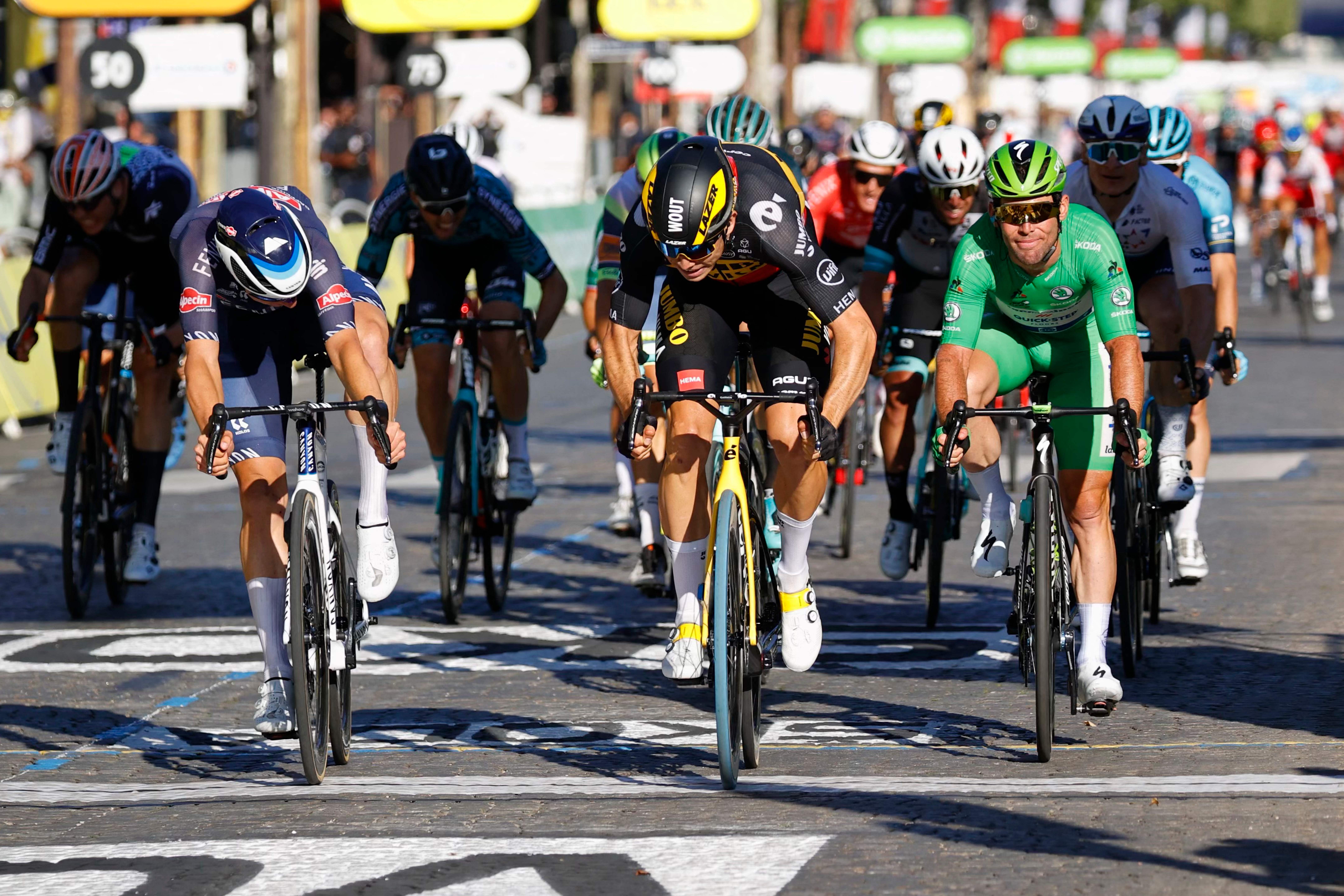'Dangerous... a shame' – Tour de France Champs-Elysées sprint winners criticise redesigned Paris stage finale
Race director Prudhomme says 'the glorious uncertainty of the sport will return' amid negative reactions from riders to Montmartre climbs inclusion

Two former winners of the Champs-Elysées sprint at the Tour de France have criticised the redesigned route for the final stage of cycling's biggest race, announced on Wednesday by organisers ASO.
Wout van Aert (Visma-Lease a Bike), who triumphed in Paris in 2021, said it was "dangerous" to add the three ascents of the Côte de la Butte Montmartre, which characterised last year's Paris Olympic Games road race, to the typical procession stage.
Despite the more Classics-style route likely benefiting someone like Van Aert, who was one of the strongest on the short climb alongside Mathieu van der Poel (Alpecin-Deceuninck), and whose teammate Remco Evenepoel won the gold medal for Belgium, he expects the different peloton size to be the key problem.
"I'm not really a fan of it. I think it's going to be a dangerous stage," Van Aert told Sporza, speaking at the Giro d'Italia. "The course is obviously something that suits me, especially when that last climb is 6km from the finish. That opens up perspectives for classic riders like me.
"But it ignores the fact that we arrived there during the Games with a peloton of 50 riders and now with an entire Tour peloton, where many classification riders still have something to defend. I expect chaos, I think it's a shame that we're going to seek that out."
Despite the incredible spectacle, where an expected 500,000 fans came out to watch the Olympic Games road race, Van Aert thinks the safety aspect is paramount and not being prioritised.
"I understand that the organisation thought 'That looks cool, we should try to use that,'" he said. "But in recent years, safety has increasingly become an issue, and this choice for Montmartre ignores this."
The latest race content, interviews, features, reviews and expert buying guides, direct to your inbox!
Compatriot and 2022 sprint winner on 'the most famous avenue in the world', Jasper Philipsen (Alpecin-Deceuninck) has a similarly negative opinion, with his chances of repeating victory on the cobblestone street being reduced.
"As a sprinter, it's clearly a shame to see this stage change. It had become a magnificent tradition," Philipsen told L'Equipe.
"The stage will become significantly more demanding for the sprinters, simply because there will be more riders capable of winning it. But that doesn't mean that a sprinter can no longer win it."
Philipsen was less interested in the safety aspect, acknowledging how any potential chaos depends largely on how the GC situation is at the beginning of the final day. However, he did note how encouraging a chance to move up on the final day, with Montmartre included, breeds more risk.
"An important factor going into this final stage will be the classification and the time gaps between the overall contenders. If everything stays close, the stress level in the peloton will definitely increase, especially as we approach Montmartre," he said.
"None of the overall contenders will want to lose even a second, as the stage offers a final opportunity to move up the top 10 and gain valuable seconds.
"In previous years, the overall teams could just enjoy a more relaxed day, but now they'll have to stay completely focused until the end. Once again, this will change the overall tension in the peloton."
Earlier this week, two-time Tour winner Jonas Vingegaard criticised the idea from a safety perspective, while Evenepoel has also previously voiced his doubts about adding the Montmartre climbs.
Tour de France race director Christian Prudhomme defended the organiser's decision to create more of a spectacle on stage 21, citing initial negative responses to one of the Tour's most iconic climbs, the Tourmalet, was first included as proof that building the "legend" of the race requires some risk.
"It was obvious to us that we wanted to do something big for the 50th anniversary of the first arrival on the Champs-Elysées," Prudhomme told Sporza.
"This will further increase the prestige of the Tour all over the world. It will allow cycling to further build its legend.
"When Henri Desgrange (the driving force behind the first Tour – Ed.) first included the Tourmalet and the Pyrenees in the route in 1910, not everyone was thrilled. Now they are part of the legend of the Tour. We must continue to build on that legend."
While the Rue Lepic and Montmartre's inclusion into the Tour will be a feature of 2025 and a huge talking point ahead of a possibly chaotic final day, it's unclear yet whether the narrow streets of northern Paris will become a mainstay.
But Prudhomme's pursuit of "legend" and wanting to ensure "the glorious uncertainty of the sport will return" suggest that this type of final stage could be here to stay.
He wants someone, like Bernard Hinault did in 1979 and 1981, to win in France's capital wearing the yellow jersey, closing out the Tour de France in style. However, he did admit that this was part of "a crazy dream."

James Moultrie is a gold-standard NCTJ journalist who joined Cyclingnews as a News Writer in 2023 after originally contributing as a freelancer for eight months, during which time he also wrote for Eurosport, Rouleur and Cycling Weekly. Prior to joining the team he reported on races such as Paris-Roubaix and the Giro d’Italia Donne for Eurosport and has interviewed some of the sport’s top riders in Chloé Dygert, Lizzie Deignan and Wout van Aert. Outside of cycling, he spends the majority of his time watching other sports – rugby, football, cricket, and American Football to name a few.
You must confirm your public display name before commenting
Please logout and then login again, you will then be prompted to enter your display name.
